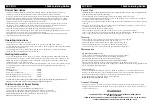
MICRON
T 2444 Soldering Station
MICRON
T 2444 Soldering Station
Care of Tips
Important: Remove the tip and clean after every use of at least once a week, remove any loose build
up in the barrel or tip to prevent tip seizing.
The tips supplied are iron plated copper and if used properly will last a long time.
1 Always keep tip tinned before returning the iron to the holder prior to switching off or storing for
any period of time, wipe only before using.
2 Don't keep iron set at high temperatures for long period as this will break down the surface plating
of the tip.
3 Don't use excessive pressure on a tip or rub a tip on a joint during the making of a joint as it does
not improve heat transfer and damages the tip.
4 Never clean tip with abrasive materials or files.
5 Don't use fluxes containing chloride or acid. Use only rosin or activated rosin fluxes.
6 If any oxide film does form, this can be cleaned by carefully rubbing with a "600-800 grit" emery
cloth, or isopropyl alcohol and re-heat. Re-tin the tip using rosin core solder.
New tip
Care for the new tip according to the following procedures for longer tip life.
1 Set temperature at 250°C, then turn main power switch "on".
2 Flood the tinned surfaces with rosin core solder after reaching 250°C.
3 Set to desired temperature after warming at 250°C for three minutes.
4 The iron is ready for use after reaching the pre-set desired temperature.
Maintenance
Tip Replacement and Dressing
1 Turn off the iron and disconnect the mains plug from the mains supply.
2 Allow the iron to cool completely before attempting disassembly.
3 Unscrew the knurled nut, and remove the barrel assembly.
Note: the ceramic heating element may be broken by careless handling.
4 Remove the tip, and blow out any accumulated dust. Avoid getting dust in your eyes.
5 Replace the tip and screw back the retaining knurled nut and barrel assembly using only firm hand
pressure to tighten.
Do not use pliers.
Filter Replacement
Under normal operating conditions the filter should be replaced once a month or when excessive
dust has obviously adhered to or discoloured the filter. Failure to change the filter regularly will
directly affect the absorption capacity and effectiveness of the fume extractor.
Follow the directions on the back page to replace the filter.
Replacement filter part number: T 1291
General Cleaning
The outer case of iron or station may be cleaned with a damp cloth using small amounts of liquid
detergent. Never douse the unit in liquid or allow any to enter the case of the station. Never use any
solvent to clean the case.
WARNING
• THE APPLIANCE IS NOT INTENDED FOR USE BY YOUNG CHILDREN OR INFIRM PERSONS
WITHOUT SUPERVISION.
• YOUNG CHILDREN SHOULD BE SUPERVISED TO ENSURE THAT THEY DO NOT PLAY WITH THE APPLIANCE.
• THE SOLDERING IRON MUST BE PLACED ON ITS STAND WHEN NOT IN USE.
Product Description
The Micron T 2444 Temperature Controlled Soldering Station with Fume Extractor has been
developed to meet the present and future needs of the electronic production industry.
It incorporates electronic circuitry which enables the user to change the tip temperature from 250°C
through 430°C without changing the tip or heating element. The transformer-less power supply
ensures excellent temperature stability by accurately monitoring the minute changes in element
resistance which occur in proportion to temperature variations.
The electronic opto isolated "zero voltage" switching used protects voltage and current sensitive
components, such as CMOS devices, against transient voltage spikes, which can be caused by
switching the power or heater on/off, or other environmental conditions.
The ceramic heating element is designed specially to bring the element temperature up to
approximately 565°C at full setting in under one minute. The higher temperature allows for reserve
heat to ensure ultra fast recovery at lower temperature settings.
The high insulation of the ceramic heating element is over 100M ohm and the tip is grounded to
ensure leakage is less than 0.4 millivolts.
Operating instructions
1 Seat the iron into the stand provided.
2 Plug in the power cable and slide the switch to 'on' position then LED lamp will be on.
3 Set temperature by rotating temperature control knob on the front panel to the temperature desired.
4 Always keep the sponge wet.
5 Set the temperature control knob to the minimum when temporarily not using the soldering
station, thereby extending the life of heater and tip.
Working Temperature
A low iron temperature will slow the flow of solder. A high temperature will burn the flux in the
solder, which in turn will emit a heavy white smoke, that can result in a dry joint or damage to the
PCB. When the tip working temperature is within the correct parameters suited to the particular
solder being used, a good joint is assured.
The most common solder alloy used in the electronics industry is 60% tin, 40% lead (60/40). The tip
working temperature of solder is detailed below and can vary slightly from manufacturer to
manufacturer.
Melting point .............................................................
215°C
Normal Operation.....................................................
320°C
Production Line Operation ......................................
380°C
Desoldering Operation for Small Joint...................
320°C
Desoldering Operation for Larger Joint.................
400°C
Caution: Temperatures above 400°C should not be used for normal soldering purposes; however
temperatures above 400°C may be used for short periods when required.
Possible causes of tip not tinning
1 Tip temperature higher than 400°C
2 Working surface is not well tinned during idling periods
3 Lack of flux in soldering, wicking, repairing and touch-up etc. operations.
4 Wiping tip on high sulphur content sponge, dirty or dry sponge and/or rags.
5 Contacting with organics, plastic resins, silicone grease, and other chemicals.
6 Impurities in solder and/or low tin content.










